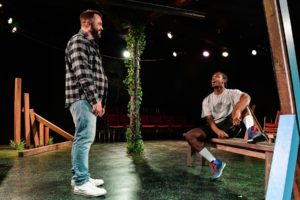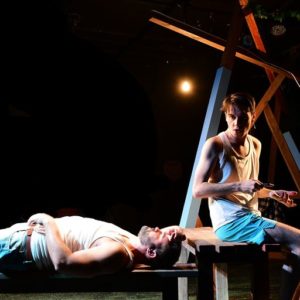
 [rating=2]“St. Sebastian” has a lot of promise but misses the mark. In this world premiere production by Refracted Theatre Company, playwright Andrew Kramer wants to marry two different themes: a discussion of the relationship between racism, gentrification, and racial prejudice and a discussion of the joys and hardships surrounding what it means to be gay. Unfortunately, the challenges of taking on both sets of topics simultaneously detracts from each of them, and Kramer does not adequately capture the nuances involved in dealing with such complexity.
[rating=2]“St. Sebastian” has a lot of promise but misses the mark. In this world premiere production by Refracted Theatre Company, playwright Andrew Kramer wants to marry two different themes: a discussion of the relationship between racism, gentrification, and racial prejudice and a discussion of the joys and hardships surrounding what it means to be gay. Unfortunately, the challenges of taking on both sets of topics simultaneously detracts from each of them, and Kramer does not adequately capture the nuances involved in dealing with such complexity.
The story centers around the gay relationship between two men who obviously love each other but have a significant difference of opinion. Ben (Adam Thatcher), who is white, purchases a house in suburban Robbins, Illinois, in a historically black neighborhood. His plan is to fix up the house and improve it so much so that he can eventually flip it and make some money. Gideon (Mack Spotts), his lover, is also white but some years younger than Ben. After the two men move into the house, Gideon says that he’s done some reading and sincerely believes that it is wrong for white people to displace black people and gentrify an all-black neighborhood by purchasing a rundown house, fixing it up, and then flipping it. He also points out to Ben that two white homosexual men living in an all-black community will make the neighbors talk and possibly be the source of hate against them.
The most refreshing parts of the performance are when Reuben (Nolan Robinson) shows up on the scene. He is either a black child or a young man whose age is never made clear, considering that he is being played by an actor who is older than the character. Reuben’s verbal give-and-take with Ben and later with Gideon is nicely done, and he inserts some needed humor into a ponderous plot. When Ben and Reuben spar about how white people perceive of black people, the two eventually become friends. Ben pays Reuben to fix up the yard, while at the same time Ben fixes up the house; we watch him move some blue beams into place in a very intriguing wooden set, minimalistic but innovatively designed by Catalina Niño. It turns out that Gideon, the seeming “over-the-top liberal” is the one who is afraid of living in a black neighborhood and eventually buys a gun. Ben is the “live and let live person”, unconstrained by ideology and thoughts about what other people think.
Too many times as the plot moves towards dealing with race relations, the story shifts to the gay theme in (what seems to be) a rather forced way. Of course, we all know that our lives are multidimensional and that there are many layers to our personality. But if the story is supposed to make some kind of statement, then the playwright should make a choice and subsume one plot to the other. In my opinion, too much time is focused on Gideon’s and Ben’s relationship, which takes away from the story as a whole. The focus on sexual orientation thus becomes an “easy out” (especially at the end) when the playwright doesn’t know how to handle the racism “can of worms” he has just opened. Unfortunately, the characters are frequently too busy lecturing the audience or arguing with each other, so that we don’t have a free moment to decide in our own minds what all this means to us and what it means to “live and let live.”
In addition, the story deals with, what sociologists call, “two different levels of analysis”: that of the individual and that of the larger group. Ben’s side of the argument is that of the individual, who focuses on attaining better financial prospects for himself and his lover. “This is the right choice for us”, he says, referring to living in a fixer-upper house. Gideon’s side of the argument (at least at the very beginning of the show) is that issues of social justice and the needs of the wider community ought to predominate as compared to seeing the world from a narrow material interest.
What is good about this show is that during its course, we see both characters change. Ben becomes more understanding of his neighbors, whereas Gideon less so. Having said that, it is not irrational (and not hypocritical) to hold two distinct viewpoints in your own mind which, on the surface, may appear to be contradictory. This is the nuance that most of the show sorely lacks. For example, one may believe that people are innately good, while at the same time recognize the need to protect and defend oneself, such making the decision to own a gun or take self-defense lessons. Unfortunately, violence and crime have become a harsh reality in today’s world, whether it has to do with street crime, burglary, or mass shootings. It doesn’t matter if you are black or white or a member of any community (whether it be racial, ethnic, or based on sexual orientation). It is interesting to learn that all the characters are realists in how they perceive their own lives, given their very different life experiences. Reuben knows he has to deal with his father, and ultimately father’s perspective influences his view of the world, whereas Gideon and Ben clearly realize that they have to deal with each other.
Finally, the idea of St. Sebastian is introduced to highlight the gay theme. This is a religious figure who both Gideon and Ben believe could be (in my words) the patron saint of gay men. What was said in the show was St. Sebastian hung around men “too much” and arrows were shot into his heart by intolerant people. A woman saved him from his death by nursing his wounds. Unfortunately, the introduction of this religious statue into the story seems too much like an “add on.” When far too much dialogue is centered around the meaning of the statue, it simply doesn’t make sense.
The best parts of the production are the direction by Graham Miller and the unusual lighting of the set by lighting designer Levi Wilkins. Portions of the wooden beams are turned into light bars, which flash and change color at unusual breaks within the performance. This demarcation of segments of the show by lighting is done very well. Costume design by Emily N. Brink is nicely appropriate.
When I go to the theatre, I’m not there to attend a lecture or a rant, whether I agree with the basic premise or not. I may want to become better educated, but I also want to be entertained. “St. Sebastian” suffers from too much needless dialogue and is vastly overdone. The occasional conversations between Ben and Reuben about race make the show enjoyable and humorous but are insufficient. I wanted more and better! My suggestion is that the playwright needs to engage a collaborator: a person of color with whom he can bounce off ideas and create a more authentically sounding story that would hold the audience’s interest for a longer stretch of time. It is not an exaggeration to say that I looked at my watch every ten or fifteen minutes and wondered when the show will finally end.
“St. Sebastian” is playing through October 2, , at the Den Theatre, 2B, 1331 N. Milwaukee Avenue, Chicago.
Tickets are $18, available at https://thedentheatre.com/.
Group rates are available. Contact admin@refractedco.com with GROUP SALES in the subject line.
 Performance schedule:
Performance schedule:
Thursdays, 8 p.m.
Fridays, 8 p,m.
Saturdays – 8:00 p.m.
Sundays – 3:00 p.m.
COVID guidelines: The Den continues to require proof of vaccination for the indefinite future. While masks are strongly encouraged throughout the venue, masks are required inside theatre 2B itself.
To find more about this company, visit www.refractedco.com

To see what others are saying, visit www.theatreinchicago.com, go to Review Round-Up and click at “St. Sebastian”.






More Stories
“The Firebugs” reviewed by Julia W. Rath
“The Book of Grace”
“The Last Five Years” MILWAUKEE